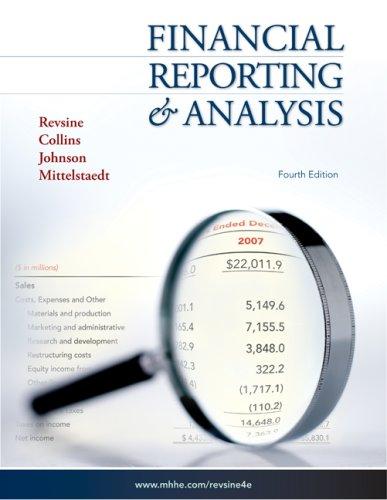The following excerpt is from an article appearing in The Wall Street Journal. LOW-BALLING: HOW SOME COMPANIES
Question:
The following excerpt is from an article appearing in The Wall Street Journal.
LOW-BALLING: HOW SOME COMPANIES SEND STOCKS ALOFT What makes a stock a high flyer? Consistently beating the analysts’
estimates helps a lot. And many companies seem to have figured out a way to try to help ensure that happens.
Each quarter, after securities analysts estimate what the companies they follow will earn, the game begins. Chief financial officers or investor relations representatives traditionally “give guidance” to analysts, hinting whether the analysts should raise or lower their earnings projections so the analysts won't be embarrassed later.
The following excerpt is from an article appearing in The Wall Street Journal.
And these days, many companies are encouraging analysts to deflate earnings projections to artificially low levels, analysts and money managers say. If the game is played right, a company’s stock will rise sharply on the day it announces its earnings—and beats the analysts’ too-conservative estimates.
Take U.S. Healthcare Inc. Late last year, some analysts say, executives of the health-care services company led them to figure it would post fourth-quarter earnings of about 45 cents a share. On Jan. 28, U.S. Healthcare announced a “preliminary”
earnings estimate of 55 cents a share. Then, only two weeks later, U.S. Healthcare shocked Wall Street by posting a whopping 68 cents a share for the quarter. The company’s stock surged 10% that day, closing at $40.625.
Several analysts think that they were misled. “U.S. Healthcare may have beat its own internal estimates, but it also wanted to guide analysts to numbers they knew they could beat,” says Kenneth Abramowitz, a health-care analyst who follows the company for Sanford Bernstein and Co.
Costas Nicolaides, the company’s chief financial officer, says US. Healthcare simply did better than it expected. “I don't guide analysts,” he says. “But if someone were to come up with a ridiculous figure, I might raise my eyebrow, or my body language would be such that theyd know.’
Money managers and analysts say an increasing number of companies are leading analysts to underestimate their earnings.
“More companies,” especially those in such growth areas as health-care and technology, “are starting to coerce us to a high degree about what our estimates should be,” says Michael Stark, a research analyst with Robertson Stephens & Co. in San Francisco. “They're always low-balling”
Analysts and portfolio managers say that some companies consistently report earnings that are just a little bit better than what they lead analysts to believe. They mention T2 Medical Inc. and Cirrus Logic Inc.; both “understate by pennies,’ says Robert Czepial, who runs the Robertson Stephens & Co. Growth Fund. “Of course they're managing the information,” he says.
A spokesman for T2 declines to comment. Cirrus’s chief financial officer, Sam Srinivasan, says that “Cirrus doesnt play the game of being conservative with the numbers for the analysts.”
One corporate chief financial officer, speaking on the condition of anonymity, says that analysts, not the company he works for, are to blame for the company’s low-balling its projected earnings. “If the Street's looking for 10 cents and you do nine, youre a moron,’
he says. “If they're looking for 10 and you do 11, you're a hero”
But low-balling may not work forever. That's the conclusion that some analysts draw from the case of AST Research Inc. For more than five quarters, several analysts and money managers say, the Irvine, Calif., computer maker consistently led them to believe it would earn at least five cents a share less than the actual results.
But for this year’s first quarter, analysts lifted their projections, running far ahead of the company’s “guidance.”
Last month, when AST announced its earnings for the quarter, its stock fell $1.875 to $28.125—even though AST’s results were in line with numbers it had given analysts.
Required:
. Briefly discuss why managers’ forecasts of earnings may be useful to financial analysts and investors.
. Why might managers steer analysts toward conservative earnings estimates by issuing earnings forecasts that they know are below the earnings they expect to report?
. As an analyst, what action(s) would you take with firms that consistently issue conservative earnings forecasts?
. Are there any disadvantages to firms (or their managers) issuing conservative earnings forecasts?
. The article claims that firms can consistently “low-ball” analysts by issuing conservative earnings forecasts and then expect to see their stock prices increase when reported earnings are “higher than expected.” Do you agree or disagree with this claim? Why?
Step by Step Answer:





